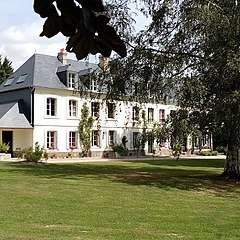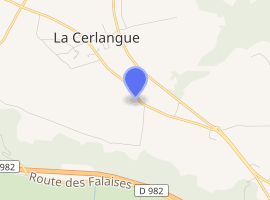Manoir du Clap
Manoir du Clap is an old manor located in the Cerlangue Village, in upper Normandy. The domain of "Le Clap" also shows old stables, an ancient shed, and some other buildings. The older part of the Manor house was built at the end of the 16th century, under the reign of Henry IV of France. It was widened at the end of the 18th century, and at the end of the 19th century.[1]
| Manoir du Clap | |
|---|---|
 | |

| |
| General information | |
| Country | France |
| Coordinates | 49°30′00.3″N 0°25′17″E |
| Construction started | Sixteenth century |
| Construction stopped | Around 1900 |
| Owner | Prévost Family |
History
During the 11th century, the village of La cerlangue was at the edge of the Lillebone forest. Lillebone was an important city that has been widened and expanded by Richard II in 1025. It became the chief town of the duchy, thanks to William the Conqueror.[2] At that time, La Cerlangue was a part of the barony of Tankerville. Jacques Le Maho describes the town as a "domaine non fieffé" which belongs to the Baron of Tankerville. Then it became a "comté" (French equivalent of an Earldom), under the dominion of Jean II de Melun, the Count of Tankerville,[3] La Cerlangue was considered as the "prévosté of La Cerlangue".[4] During the Hundred Year's War, an English earldom has been created, in parallel with the French county.[5]
After that war, lords and landowners rebuilt the destroyed mansions, castles and manor houses. Manoir du Clap was built a hundred years after the conflict, in a place called "Le Clap", not far from La Cerlangue. That spot was particularly dynamic. Jens Christian Moesgaard testifies that the road starting from Tankerville, reaching La Cerlangue and going through Le Clap was a local economical node.[6] A noble family decided to build a manor house in this dynamic place. This is the first frame of the Manoir du Clap. A Rapier and old pieces of furniture attest that this settlement happens during the reign of Henry the IVth, and, more precisely, between 1590 and 1608.
In 1740, the Manor was bought by the Yon Family, who modified it. The family added 18th century mouldings (Louis XV, Louis XVI and Directoire styles).[1]
At the end of the 19th century, the mansion is enlarged, and a big banquet room is added to the building. The now bigger house could host special guests. Arthur Honegger was one of them. He recited "Jeanne d'arc au Bûcher" to the family in 1935.[1]
References
- Lebourgeois, Patrick., La Cerlangue : sur les falaises de l'estuaire, Éd. des Falaises, impr. 2012
- Jacques Le Maho, « L'apparition des seigneuries châtelaines dans le Grand-Caux à l'époque ducale », Archéologie médiévale, vol. 6, no 1, 1976, p. 5–148
- Provinces, pays and seigneuries of France, P.D. Abbott, 1981
- Deville, Achille, 1789-1875., Histoire du château et des sires de Tancarville, Le Livre d'histoire, impr. 2009
- Avenel, Alain., Tancarville : un château, un canal, un pont, toute une histoire, Falaises, 2008
- Jens Christian Moesgaard, « La circulation des monnaies noires en Haute- Normandie, 1337-1577 », Revue numismatique, vol. 6, no 165, 2009, p. 221–305